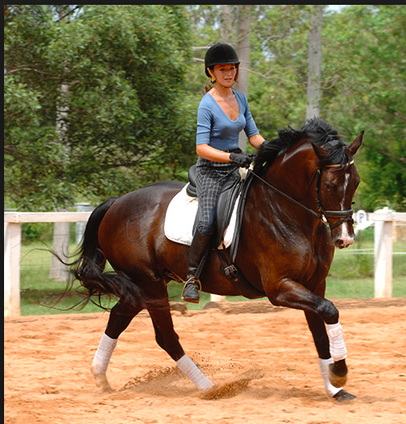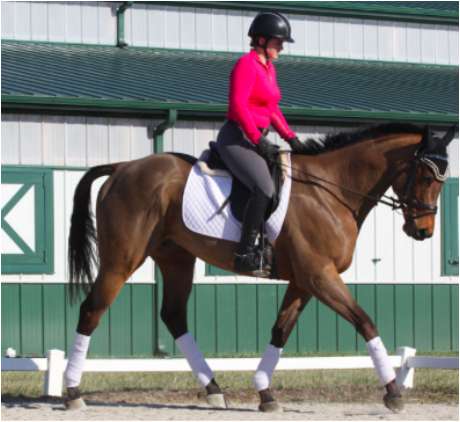What Happens When You Release the Inside Rein On A Circle?
The answer is nothing: The horse's tempo, rhythm, and bend shouldn't change. If any of them do, you're riding wrong.
Joyce was getting pretty tired of hearing her trainer yell "Inside leg into the outside rein!" as she cantered on a circle. So she yelled back, "I'm already doing that!"
"OK, so try this," her trainer called. "Push your inside rein slightly forward toward your horse's nose. And stay on the circle. Don't change anything else."
Joyce gingerly released her inside rein as asked. And everything fell apart. Her horse lunged forward, speeding up his canter. He lost his frame, leaned down toward his inside knee. And the circle ceased to exist.
"Uh, I guess I don't exactly have that yet," Joyce conceded sheepishly.
"No problem," her trainer assured her. "That's going to be our lesson for today."
Don't Pull Your Horse's Nose Around
Many riders (even at advanced levels) ride circles and turns by pulling their horse's nose around. In fact, they can't imagine it is possible to maintain a circle or turn a horse without increasing pressure on the inside rein.
The thing to keep in mind is that the inside rein can serve as an emergency brake, as shown in this video.
"OK, so try this," her trainer called. "Push your inside rein slightly forward toward your horse's nose. And stay on the circle. Don't change anything else."
Joyce gingerly released her inside rein as asked. And everything fell apart. Her horse lunged forward, speeding up his canter. He lost his frame, leaned down toward his inside knee. And the circle ceased to exist.
"Uh, I guess I don't exactly have that yet," Joyce conceded sheepishly.
"No problem," her trainer assured her. "That's going to be our lesson for today."
Don't Pull Your Horse's Nose Around
Many riders (even at advanced levels) ride circles and turns by pulling their horse's nose around. In fact, they can't imagine it is possible to maintain a circle or turn a horse without increasing pressure on the inside rein.
The thing to keep in mind is that the inside rein can serve as an emergency brake, as shown in this video.
If you try to drive your horse forward on a circle while simultaneously gripping the inside rein, you are essentially pressing on the gas pedal and the brake at the same time. Here is a brief video showing a rider doing exactly that. Notice how the trainer successfully guides the rider in using her inside leg to activate the horse's inside hind leg. But because the rider is also hanging onto the inside rein in an attempt to "keep the horse on a circle", the horse alternates between driving forward and slowing down. Very confusing for the horse
If you try to drive your horse forward while simultaneously gripping the inside rein, you are pressing the gas pedal and the brake at the same time.
If you try to keep your horse on a circle by pulling on the inside rein, you will bottle up his energy, cramp his forward movement, and distort his gait, as shown in this very brief video:

So how do you keep a horse on circle, or turn him? Yes, the answer really is inside leg into the outside hand.
Look at the diagram above. Notice that the horse is bending in the barrel while the head and neck are relatively straight. The inside hind hoof steps under the body in the direction of the outside fore. To accomplish this, you must first get your horse to bend to your inside leg pressure. When you are riding, what you will feel is his ribs bend away from your inside leg.
If you just keep applying pressure with your inside leg, your horse will move his entire body away to the outside. To prevent this from happening, you must keep a firm outside rein to prevent his shoulder from popping to the outside, and you must move your outside leg slightly back and apply pressure to keep the haunches from swinging to the outside. More about how to do these three movements simultaneously and effortlessly here.
Now add a bit more pressure with your inside leg, lifting his ribs slightly with your inside heel (or gentle spur). You should feel energy from the horse's inside hind leg driving into your outside hand. And that is how you keep your horse on a circle or turn your horse.
If you just keep applying pressure with your inside leg, your horse will move his entire body away to the outside. To prevent this from happening, you must keep a firm outside rein to prevent his shoulder from popping to the outside, and you must move your outside leg slightly back and apply pressure to keep the haunches from swinging to the outside. More about how to do these three movements simultaneously and effortlessly here.
Now add a bit more pressure with your inside leg, lifting his ribs slightly with your inside heel (or gentle spur). You should feel energy from the horse's inside hind leg driving into your outside hand. And that is how you keep your horse on a circle or turn your horse.

Notice I haven't said a single thing about the inside rein. Because, no really, you don't have to pull your horse's nose to the inside in order to make him bend or turn. The inside rein can be squeezed gently to put the final touches on the horse's movement by softening his jaw. If instead, you try to turn or circle your horse by pulling his nose around with the inside rein, his outside shoulder will pop out, his neck will bend instead of his body, he will brace against your hand, and his gait will become stiff.

Now try the exercise mentioned at the beginning of this article: As you ride a circle, release your inside rein slightly forward and DO NOT CHANGE YOUR POSITION IN ANY WAY. If your horse is truly balanced on the outside rein (rather than leaning and getting pulled by the inside rein), he will continue trotting or cantering forward on the circle, and will maintain his frame. You can see that in the photo to the left.
You can also see it in this brief video of a rider releasing the inside rein while trotting on a circle. Notice also that, as pointed out in the trotting video, releasing the inside rein this way teachers your horse to NOT lean on your hands. You essentially tell your horse "Don't expect me to hold your head up for you."
And here is one of a rider releasing the inside rein while cantering on a circle.
Finally, notice that when riding circle (or turning) correctly, your hands always remain opposite each other. A common and disastrous mistake that riders often make in riding or turning is pulling the inside rein back toward their bodies, while allowing the outside hand to float forward. Your hands should remain like bookends above (advanced) or on either side (beginner, intermediate) of your horse's wither. The rider on the left is holding the reins correctly while cantering on a circle. The rider on the right is pulling the inside rein back while allowing the outside rein to float forward.
Happy Riding!
Copyright May 20, 2016, Denise Cummins, PhD; Updated June 25, 2024
The Thinking Equestrian
As long as you’re here, check these out!
Equestrian Products That Make Your Riding and Horse Care Easier and Better!
How to develop elastic rein contact
Dressage for Everyone
What’s the Difference Between Working, Medium, and Extended Trot?
How to Get a Horse to Lengthen His Stride
How To Half Halt Your Horse
Opening Photo Credit: www.horseproblems.com.au
Copyright May 20, 2016, Denise Cummins, PhD; Updated June 25, 2024
The Thinking Equestrian
As long as you’re here, check these out!
Equestrian Products That Make Your Riding and Horse Care Easier and Better!
How to develop elastic rein contact
Dressage for Everyone
What’s the Difference Between Working, Medium, and Extended Trot?
How to Get a Horse to Lengthen His Stride
How To Half Halt Your Horse
Opening Photo Credit: www.horseproblems.com.au




